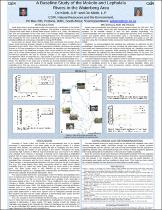JavaScript is disabled for your browser. Some features of this site may not work without it.
- ResearchSpace
- →
- Research Publications/Outputs
- →
- Conference Publications
- →
- View Item
| dc.contributor.author |
De Klerk, A

|
|
| dc.contributor.author |
De Klerk, Arno R

|
|
| dc.date.accessioned | 2011-12-14T11:29:27Z | |
| dc.date.available | 2011-12-14T11:29:27Z | |
| dc.date.issued | 2011-07 | |
| dc.identifier.citation | De Klerk, A and De Klerk, L. 2011. Baseline study of the Mokolo and Lephalala rivers in the Waterberg area. 2nd Regional Young Water Professionals Conference. CSIR International Convention Centre (ICC), 4-5 July 2011 | en_US |
| dc.identifier.uri | http://hdl.handle.net/10204/5417 | |
| dc.description | 2nd Regional Young Water Professionals Conference. CSIR International Convention Centre (ICC), 4-5 July 2011 | en_US |
| dc.description.abstract | A study was conducted in the Waterberg area to characterize the aquatic macro invertebrate community structure and fish assemblages in the Mokolo and Lephalala rivers prior to the onset of increased mining activities and coal fired power stations. This study was carried out over a three-year period from 2008 to 2010. Aquatic macro invertebrates were sampled from all the different biotopes (vegetation, stones, gravel, sand and mud) using a standard sweep net method, whilst fish were sampled using an electro-fishing technique. Statistical analyses were used to reveal spatial and temporal changes in the macro invertebrate community structure, whilst a sensitivity indicator value was derived to provide an overall indication of the sensitivity of fish species to physics-chemical parameters and no-flow conditions. The percentage integrity was categorized according to the approach followed in the Fish Response Assessment Index. The results indicated that in both the Mokolo and Lephalala rivers there is a gradual change in the macro invertebrate community structure as well as the fish assemblages in a longitudinal gradient from the upper reaches to the sites located further downstream. All the fish sampled were in a healthy condition and showed no signs of external abnormalities or illness. The collection of certain macro invertebrate and fish species indicated that the water quality in both rivers tends to be relatively good, with the headwater tributaries of each river having relatively pristine conditions. These headwater tributaries offer safe breeding grounds for a yet undescribed fish species from the genus, Barbus. The baseline data gained from this study provides a useful benchmark against which possible future deterioration in the water quality and ecosystem health of these aquatic ecosystems can be assessed. | en_US |
| dc.language.iso | en | en_US |
| dc.relation.ispartofseries | Workflow request;6949 | |
| dc.subject | Baseline study | en_US |
| dc.subject | Waterberg | en_US |
| dc.subject | Fish | en_US |
| dc.subject | Invertebrates | en_US |
| dc.subject | Lephalala river | en_US |
| dc.subject | Limpopo | en_US |
| dc.subject | Mokolo river | en_US |
| dc.subject | Aquatic invertebrates | en_US |
| dc.subject | Fish species | en_US |
| dc.subject | Barbus | en_US |
| dc.title | Baseline study of the Mokolo and Lephalala rivers in the Waterberg area | en_US |
| dc.type | Conference Presentation | en_US |
| dc.identifier.apacitation | De Klerk, A., & De Klerk, A. R. (2011). Baseline study of the Mokolo and Lephalala rivers in the Waterberg area. http://hdl.handle.net/10204/5417 | en_ZA |
| dc.identifier.chicagocitation | De Klerk, A, and Arno R De Klerk. "Baseline study of the Mokolo and Lephalala rivers in the Waterberg area." (2011): http://hdl.handle.net/10204/5417 | en_ZA |
| dc.identifier.vancouvercitation | De Klerk A, De Klerk AR, Baseline study of the Mokolo and Lephalala rivers in the Waterberg area; 2011. http://hdl.handle.net/10204/5417 . | en_ZA |
| dc.identifier.ris | TY - Conference Presentation AU - De Klerk, A AU - De Klerk, Arno R AB - A study was conducted in the Waterberg area to characterize the aquatic macro invertebrate community structure and fish assemblages in the Mokolo and Lephalala rivers prior to the onset of increased mining activities and coal fired power stations. This study was carried out over a three-year period from 2008 to 2010. Aquatic macro invertebrates were sampled from all the different biotopes (vegetation, stones, gravel, sand and mud) using a standard sweep net method, whilst fish were sampled using an electro-fishing technique. Statistical analyses were used to reveal spatial and temporal changes in the macro invertebrate community structure, whilst a sensitivity indicator value was derived to provide an overall indication of the sensitivity of fish species to physics-chemical parameters and no-flow conditions. The percentage integrity was categorized according to the approach followed in the Fish Response Assessment Index. The results indicated that in both the Mokolo and Lephalala rivers there is a gradual change in the macro invertebrate community structure as well as the fish assemblages in a longitudinal gradient from the upper reaches to the sites located further downstream. All the fish sampled were in a healthy condition and showed no signs of external abnormalities or illness. The collection of certain macro invertebrate and fish species indicated that the water quality in both rivers tends to be relatively good, with the headwater tributaries of each river having relatively pristine conditions. These headwater tributaries offer safe breeding grounds for a yet undescribed fish species from the genus, Barbus. The baseline data gained from this study provides a useful benchmark against which possible future deterioration in the water quality and ecosystem health of these aquatic ecosystems can be assessed. DA - 2011-07 DB - ResearchSpace DP - CSIR KW - Baseline study KW - Waterberg KW - Fish KW - Invertebrates KW - Lephalala river KW - Limpopo KW - Mokolo river KW - Aquatic invertebrates KW - Fish species KW - Barbus LK - https://researchspace.csir.co.za PY - 2011 T1 - Baseline study of the Mokolo and Lephalala rivers in the Waterberg area TI - Baseline study of the Mokolo and Lephalala rivers in the Waterberg area UR - http://hdl.handle.net/10204/5417 ER - | en_ZA |






